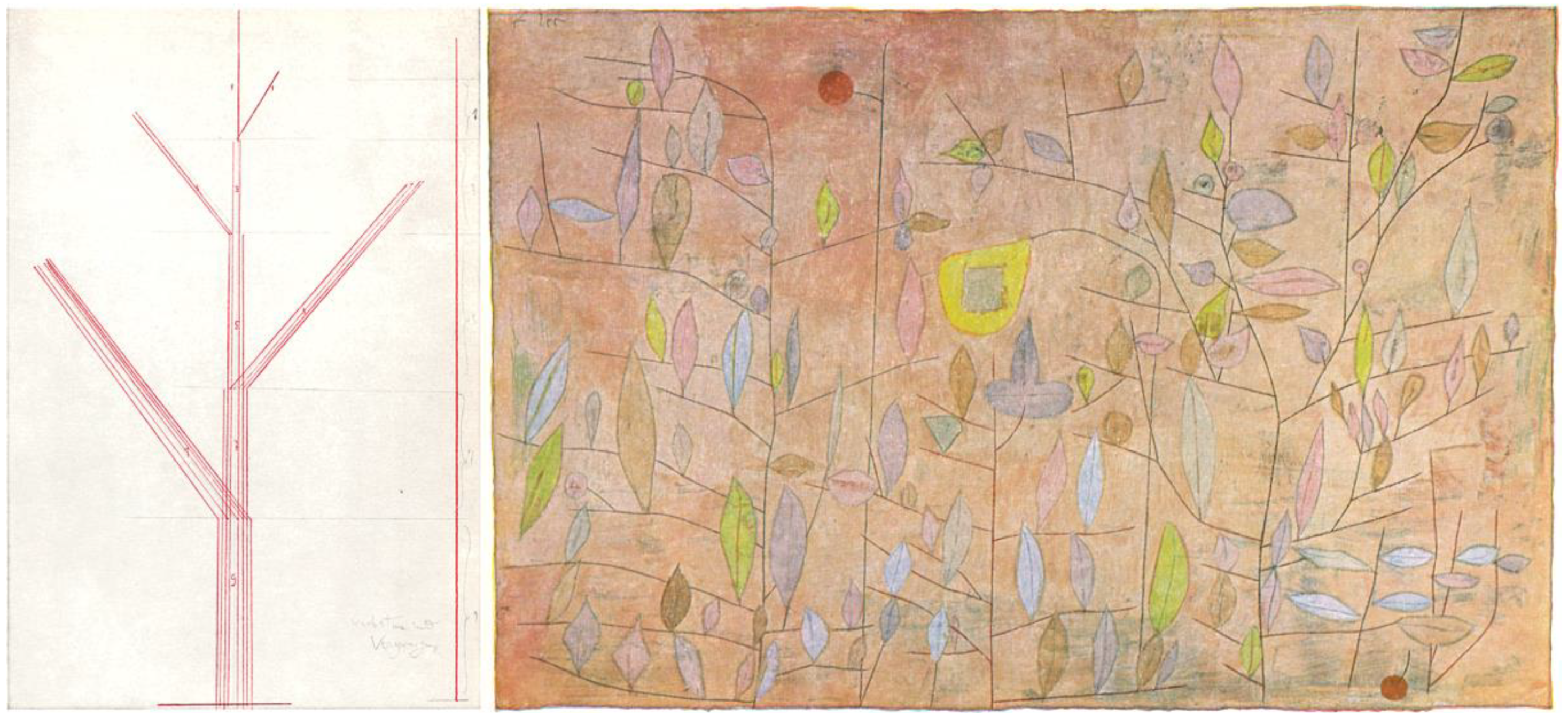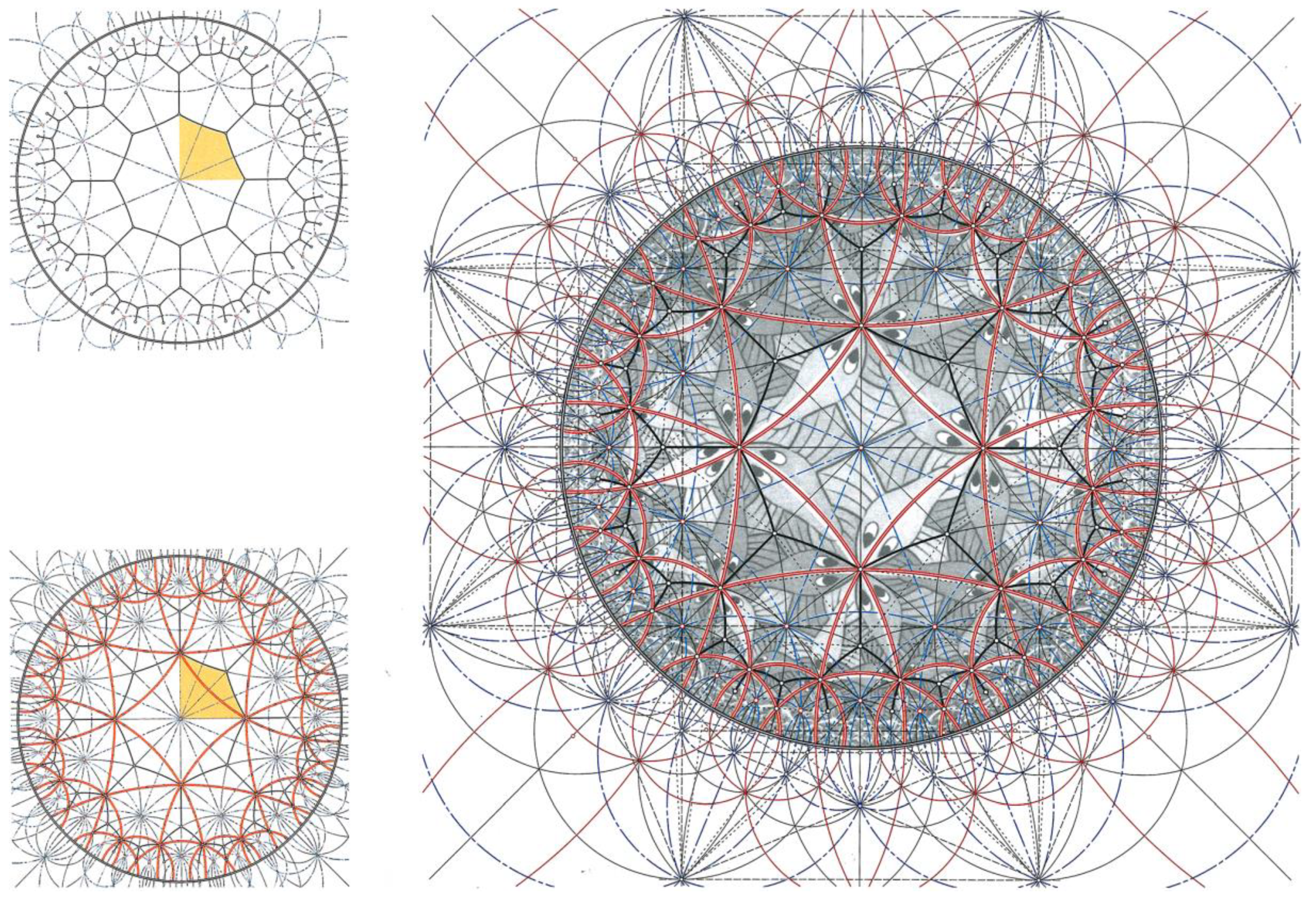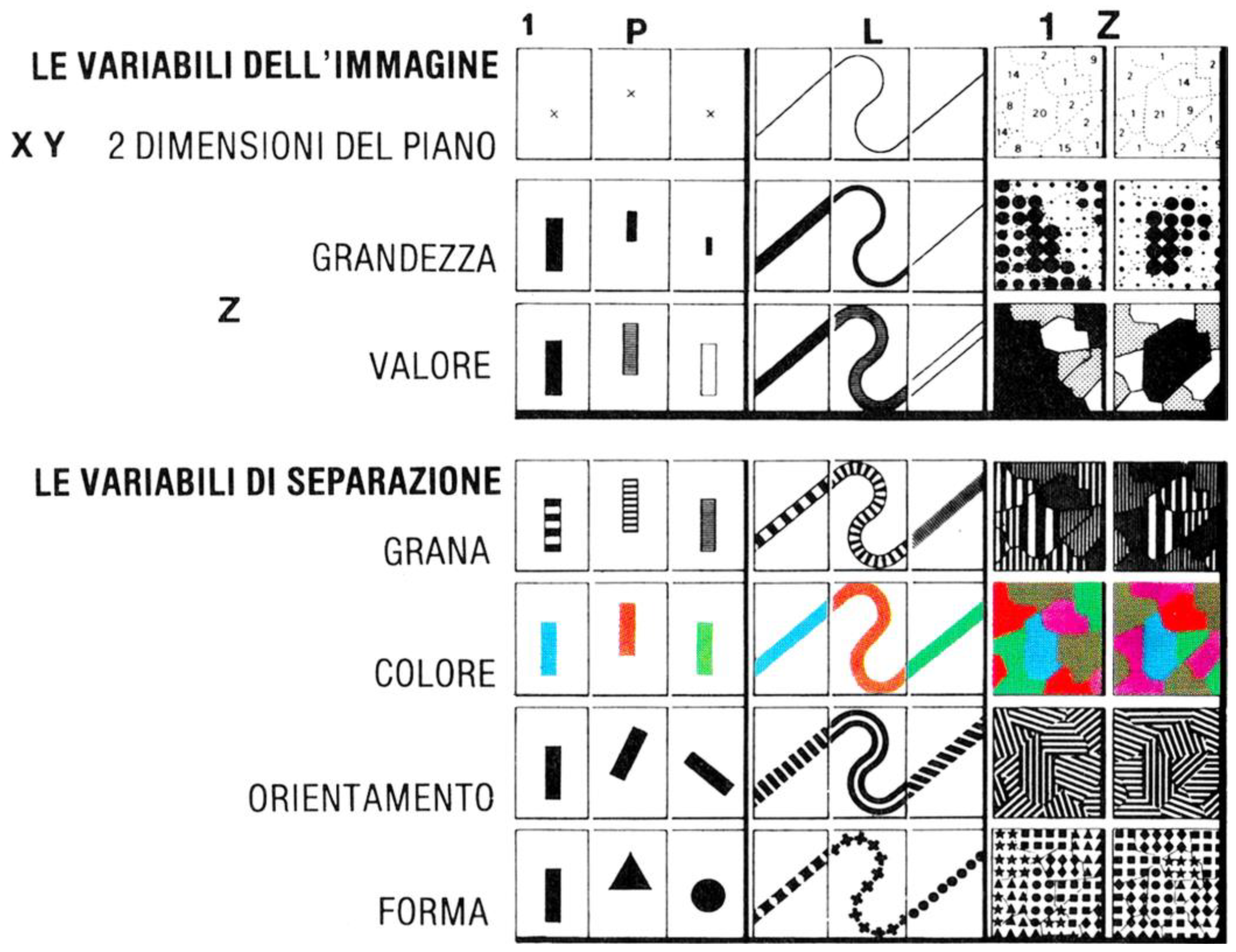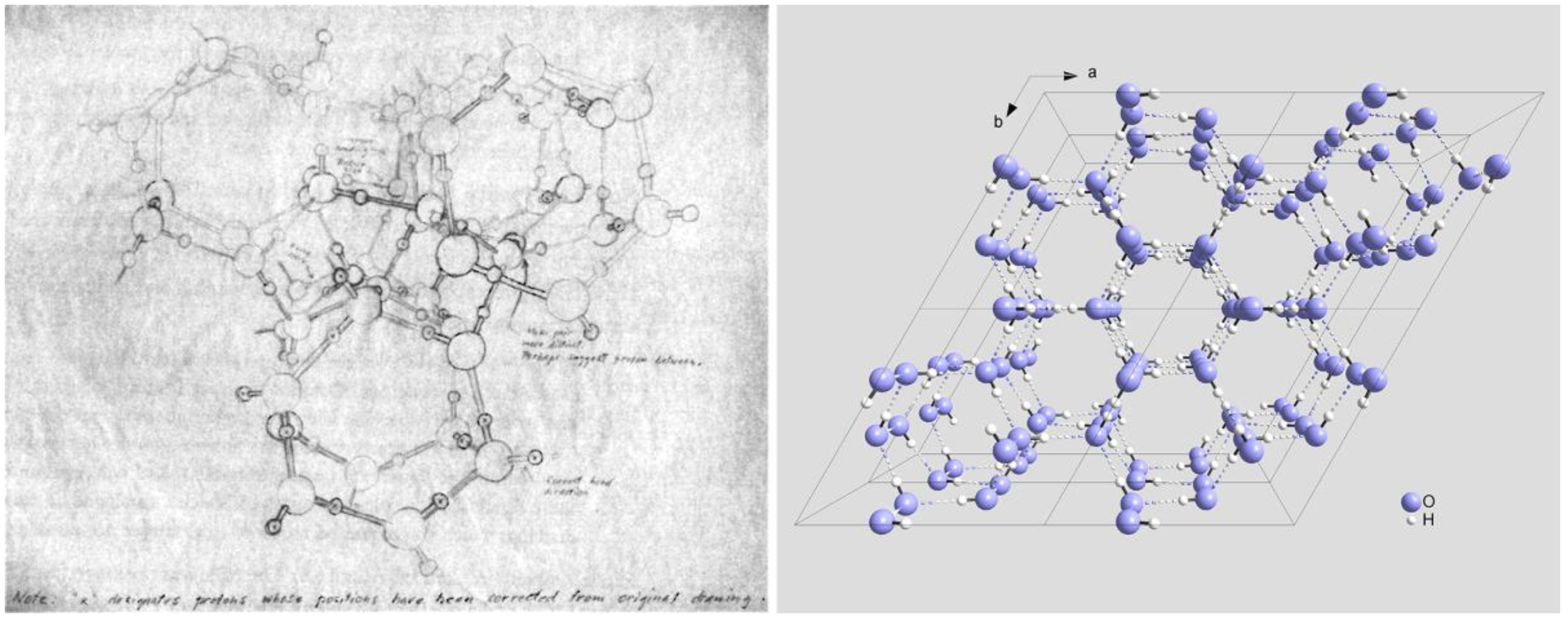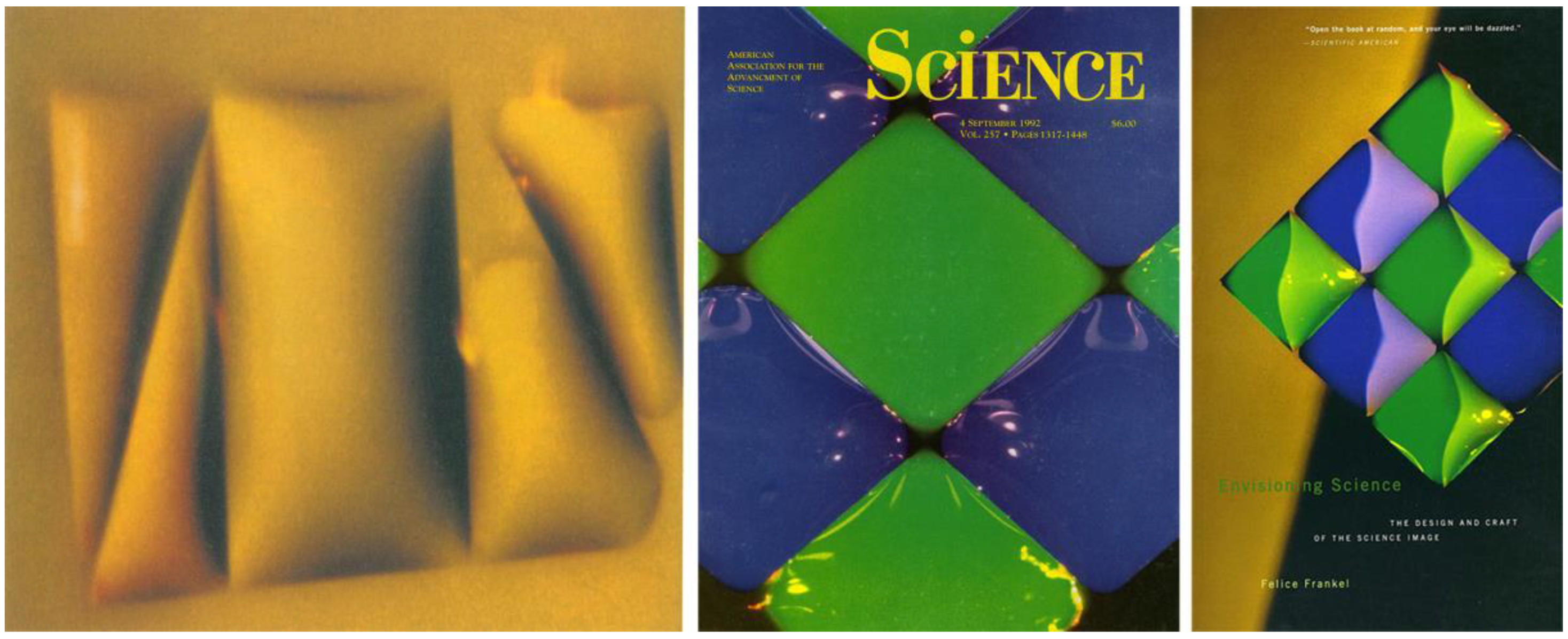1. Introduction
The “invasion” of images is a phenomenon we have been witnessing for many years. Images accompany us in our daily lives to recount, document, and explain not only the extant, which for its very nature is visible, but also the outcome of mental activities that take form in the mind. And it is precisely in the multitasking world of the image, a word with a multiplicity of meanings, that we intend to examine the relationship between the visual dimension of thought, whether scientific or artistic, and its physical transposition. This close relationship, implicit in the visual “product”, incarnates and manifests the double nature of the image because it is both a cognitive tool—insofar as its structuring component is the theoretical development of an idea—and a divulgatory instrument - insofar as an element illustrating the conceptual process for visual communication purposes. Jean-Jacques Wunenburger in his
Filosofia delle immagini, writes that “
[i]l sapere scientifico, una volta costituito e stabilito, deve ancora essere comunicato e diffuso, tanto nella comunità scientifica quanto presso un largo pubblico [...]. L’immaginario, a questo punto, non serve più a inventare, a infondere progressi, bensì a diffondere, a far comprendere: da euristico diventa didattico.” [
1] (p. 322).
Convinced, as we are, that every thought is forthcoming in the form of an image whether in the mind of whoever conceives it or in whoever uses it, the moment of its transposition into representation constitutes a signal moment, namely the time when the transfer of knowledge takes place and the non-visible becomes visible. In order for this operation to take place “that” set of theoretical-instrumental skills that produces images, and encompasses ways to make them understandable and communicable must be first mastered. The adequacy and efficacy,
efficacité for Jacques Bertin [
2], in the use of the image in various fields of knowledge posits a question regarding these theoretical-practical operational processes involved in the constitution of visual models and visual communication. Such procedures entail a specific knowledge of the organising criteria of images—an indispensable means for setting out and proposing constructive methods as a reference for operations to materialise cerebral material. It is, therefore, necessary to examine the constitutive and active aspect of the image by studying its morphology and structure. However, the pursuit of this objective entails further research into themes specific to the realms of visual, graphic and geometric sciences, whose fields of expertise can alone supply the knowledge necessary not only for discovering a key to interpreting extant images but also for outlining methods and constitutive systems within the design field. This operation, once initiated, would enable us to process images using their own language, in other words, being able to speak about them in terms of construction, processing and visual communication (
Figure 1).
There are two protagonists of the “iconic breakthrough” of the 1990s, the German Gottfried Boehm [
4] and the American William John Thomas Mitchell [
5], who a dozen years ago discussed the precocious possibility of writing a science of the image. Today, we may wonder if this is still a premature undertaking, in view of the ever-more pervasive use of images in their multiform modes of being but, at the same time, we must also realise that there is a need to finalize research linked to them. In addition, we must determine the role played in this art form by whoever wishes or has to produce such images, in other words the person that structures the elements of the visual, and identifies the ways most efficacious for “fabricating” the images that “illuminate the mind and form ideas”. Vito Cardone, in his inaugural address for the XY digital site on 10 July 2015 in Trento, underlined the need for the architect to apply the theoretical-practical study of images to the discipline of representation, albeit neglected in recent years, and reminded us that this art-form is based on the two pillars of geometry and graphic semiology: primary elements in the constitution of any type of image.
2. The Image as “Product”
If “producers” exist it means that the image can, for all intents and purposes, be deemed a “product”, formed by a component that is both conceptual—synthesising fields of knowledge—and physical—synthesising the constituent elements that render it visual. The analysis of this product, in order to subsequently re-produce it, is only possible after we have critically arranged the theoretical and practical tools that contribute to its ideation and processing. The operative areas able to identify the phases of an image’s construction refer to the following three categories: procedural, formal and relational.
All these areas will be summarily described below but for the purpose of taking that small step into the vast theme of image construction, we must dwell on the first of such three categories—and deemed the most basic—by examining the procedural aspect of making an image.
In the procedural context, the compositional processes of an image recognise geometrical studies as constant processes in the visual and material rendering of thoughts. These tools put the image’s structure together, i.e., the graphic semiology, that compose and manage signs and the tools and techniques that materialise it.
Instead in the formal context, a thought must be materialised in models that govern its depiction in order to take form as a material bi-dimensional image. The various ways such models give visual form to a “depicted object” [
6] are of three macro types, not rigidly separable one from another, within which they can be categorised. In this field, we can recognise: diagrammatic models, which illustrate quantities and identify connections between constituent elements of structure, schematic models, which manage qualitative and structural/functional components in relational/descriptive modes, and, finally, figural models, which manage not only the quantitative/qualitative but also the iconic and functional/mimetic components that develop relational-narrative type representations.
In the relational context, the image as a product establishes a relationship with the external world through dissemination methods and strategies that by the use of signs and words implement the communication modes and visual perception.
These preliminary considerations demonstrate that the road ahead is not straightforward, or without obstacles. However, a first step can be taken by dealing with the matter of the image’s constitutive aspect.
3. The Image’s Local Structure
In order to identify an image’s logical structure, it is first of all necessary to address the procedural context in order to “de-construct” the image. As often happens, prior to learning how to assemble we must first learn how to disassemble. If we are to re-compose the parts of an object in an informed manner, arranging the “parts” in such a manner as to obtain an analogous configuration, we must be familiar with the single components, and know how to identify, manage and “manipulate” them. This operation is possible thanks to the foregoing constant components identified at the analytic stage; authentic materials indispensable for visual bi-dimensional representation, as ingredients that, variously assorted, contribute towards the construction of the image as product.
Thus, through the use of geometries, thoughts non-visible to others become visible regardless of their nature as a purely imaginary or experienced reality and one then translated into a dialoguing form. They furnish the rigorous and exact datum that expresses the need to control the form of a thought and guarantees its transmissibility (
Figure 2).
“
Que doit-on penser de cette question: la geometrie euclidienne est elle vrai? Elle n’a aucun sens. Une geometrie ne peut pas être plus vrai qu’une autre; elle peut seulement être plus commode” [
9] (p. 14).
As soon as images acquire bi-dimensional materiality, they must come to terms with the spatial representation of both the existence of the object of thought and the bi-dimensional support that hosts them; i.e., the external space in which the thought is made manifest. And here geometries come into play in the productive process, to give structure to the thought and form to the figurative rendering of the images by defining the organisation of a space within the support’s bi-dimensional own space. And it is precisely the formalisation of the thought in a communicative process that implies the use of geometries insofar as they can mediate logical abstractions and empirical control and enable us to give form to daily experience. There are many spaces and relations that will wish to be divulged or disseminated and thus many geometries that try to describe them through signs. The observation of the image and the recognition of implicit forms, proceed through the intermediation of a geometry that, while concealing a presumed objectivism, actually determine the visual product’s subjectivity insofar as influenced by certain ineludible factors: the knowledge of the producer, the knowledge of the user, and current culture. The producers of images make use not only of the most well-known geometries but also lesser known ones. They use Euclidian geometry to regulate the definition of a logically constructed space, and independent of bodies-objects by virtue of its metrical rigour and capacity for abstraction. Producers likewise take advantage of projective geometry to regulate the correspondence between bodies and the analogy with the other reality by exploiting its perceptive control. They also make use of topology that governs the quality and relations between bodies, by exploiting its capacity to represent the manner in which things exist. From such geometries derive or in combination with other geometries, such as the elliptic and hyperbolic (
Figure 3), the fractal, the fourth dimension and the finite geometries, all of which set upon translating into images a life space that is “another” space, unlinked to the perceptive principle specific to seeing [
10].
There is also another geometry that should be mentioned in this context, even if not belonging to the formal geometries of mathematicians, but which is, in its intention, no less rigorous: this is the geometry of appearances or perceptive geometry, illustrated by Massironi in his book
Comunicare per immagini [
9]. The geometry of appearances is based upon the critical observation and understanding of the mechanisms that govern visual communication and its subject matter is “the evidence of the world as appearance” and as such it does not dwell upon considerations regarding the form and materiality of things, but rather seeks the phenomena and processes that determine the exteriority of events. Closely related to the figure of the imagine, it establishes a close relationship with graphic semiology and is considered the second constitutive area of images.
“
La geometria, i processi percettivi, i valori simbolici o metaforici ed il loro fondamento “mimetico” concorrono insomma a regolare la formazione dei segni ed a conferir loro un preciso significato, limitandone da un lato l’arbitrarietà o convenzionalità e rendendoli dall’altro comunicabili, immettendoli nella circolazione linguistica e culturale.” [
10] (p. 60).
Imparting meaning and sense to signs is the primary purpose of semiology, while the attribution of meaning to graphic signs, [and we could, perhaps, enlarge its remit to all signage components of images of any kind (graphic or otherwise)], is the path followed by graphic semiology, which operationally furnishes forms to control and manage signs. In order to briefly discuss this discipline we must make a brief incursion into semiology and in doing so we can cite the words of Umberto Eco: “
Decideremo pertanto—e sia chiara la convenzione che regge il discorso che segue—di chiamare “semiologia” una teoria generale della ricerca sui fenomeni di comunicazione visti come elaborazione di messaggi sulla base di codici convenzionali come sistemi di segni; e chiameremo “semiotiche” questi singoli sistemi di segni nella misura in cui siano tali, e pertanto formalizzati (se già sono individuati come tali) o formalizzabili (se sono appunto da individuare là dove non si pensava che vi fosse un codice).” [
11] (p. 545).
According to Eco, therefore, the study of semiology addresses not only systems of signs but also cultural phenomena (in their turn understood as systems of signs), but always assuming that the latter are systems of signs and that culture is essentially communication. If the premise is that any sign implies communication, (giving a sense to it and attempting to understand the meaning of the relationship between the signs), it also entails the search for the “elementary structure” of communication [
12]. By giving “communicative events” different forms, semiology creates categories that are not only identifiable with linguistic phenomena and for this reason Eco must also address other ambits such as the semiology of visual communications and the semiology of architecture [
11]. However, insofar as we are dealing with graphic semiology it is necessary to refer to the studies of Jacques Bertin on the structural organisation of sign systems specific to the graphic system. He deals with the theme of the graphic sign and graphics, which defines the mono-semiotic level of the world of images, by treating them as complex information systems and, in so doing, turns his attention to representation and the construction of graphic images. He writes that “
LA REPRÉSENTATION GRAPHIQUE est la transcription, dans le SYSTÈME GRAPHIQUE DE SIGNES, d’une pensée, d’une “information” connue par l’intermédiaire d’un système de signes quelconque. La représentation graphique est une partie de la sémiologie, science qui traite de tous les systèmes de signes.” [
2] (p. 8).
By applying a semiological approach to graphic representations, he manages to classify types and forms of relations between graphic signs, thus defining authentic syntactic and semantic tools able to identify a measurable criterion on whose basis the graphic constructions can be classified, thereby setting out a precise theoretical device with very strong operational implications (
Figure 4). His argument owes its strength to the fact that he clearly states his objective to be the question of the construction of the image, from ideation to production by evaluating all its components for the purpose of establishing the rules of construction so as to obtain that image which he defines as “
la forme significative perceptible dans l’istant minimum de vision.” [
2] (p. 142). Linking a type of sign to a meaning and wishing it also to acquire such meaning by overcoming the barrier of subjectivity, is most certainly the result of the desire to control an image so that a product unequivocally understood by both its producer and user can be produced, or as Giovanni Anceschi, writes by the “designer” and the “designee” [
6].
An image structured in this manner is a carrier of value and in the end must acquire physicality. The tools and techniques, understood as theoretical and practical components, manage the image’s material restitution and give it a concrete existence. “
La tecnica consente di mettere in relazione la disponibilità della materia con la precisa determinazione della forma e l’intero apparato strumentale, che le è implicito; essa svolge un ruolo costitutivo, non certo neutrale o banalmente funzionale. La tecnica […] non si limita a fornire i mezzi per una “traduzione” dell’idea in “prodotto”, ma fa intrinsecamente parte della concezione e del processo produttivo, lo istituisce e permane riconoscibile nei suoi esiti. E come “l’essenza della tecnica non ha nulla di tecnico”, così si può dire che l’essenza dello strumento non ha nulla di strumentale.” [
10] (p. 23).
The choice of the use of an instrument or a technology therefore contributes towards determining the meaning and sense of the image and, therefore, the use of other operational means cannot be indifferent. Instruments and technologies are endowed with their own manner of existence and relate themselves directly to the products, productive processes and their outcomes, so becoming components that are indelibly present in the works [
10]. They are thoroughgoing cultural “spokesmen” that by manifestly stating that they belong to the place and historical period in which they operate, strongly influence the way images are produced (
Figure 5).
4. The Transversal Image
Having investigated the image and clarified its inter-dependence with its primary constitutive elements we can sketch out a possible path that the thought-process may take when confronted with a visual product; a procedural path that commences from the identification, among the processes indicated, of methods suitable for translating the mental model into a material image. The material model takes form from a combination of single parts in an increasingly complex process. This model, the physical double of the thought that generated it, is a device able to function on its own, and establish the manner of its own transmission and dissemination. Thus, spelling out the model’s configuration also means orchestrating such procedures by combining the constitutive objects in relation to the type of idea to be translated and the type of image to be produced.
The management of images is transversal with respect to the various disciplines precisely because it refers to universal forms of expression and is closely related to the capacity of whoever produces images to combine the components and his/her ability to use and dose them skilfully. The “designer”, the producer of images, must be able to master them with expertise and, only if he/she participates in the logic of the thought to be represented, can he/she visibly process phenomena that albeit different have similar structural characteristics. The single components that make up these images and the manner of their representation may not vary, but most certainly the overall meaning attributed to those images in the single disciplines will vary. For example, we can compare two synthetic representations of Devin House by Frank Lloyd Wright and two representations of the bushy stunt virus (
Figure 6). Altogether, they comprise four schematic models of which the first two, respectively, illustrate components of the house and the virus while the second two define the contiguous relations between the single constitutive elements. The geometrical principle is topological geometry. The real form of the object is of no interest because the sole issue is how the single elements that comprise the image are structured together in a single body. In the first two designs of the two cases, and both carried out freehand, the communication of the relational form is performed by closed lines of non-homogenous thickness, identifying figures in bi-dimensional space on a sheet of paper supplemented by alphabetical letters—more codified graphical signs—the sole reference element to the specific case and described by a written text. The same applies in the second pair of schemes, produced using a plotter, where a line of various thickness and direction, can remain open or closed and in so doing indicates surfaces or symbols (arrows), all of which supplemented by a written text, also included in the graphic printout. The example shows how identical procedures can be used for apparently different facts having the same logical and illustrative structure.
Specific and profound knowledge enables us to attain the efficacy mentioned at the outset; that deliberate control of components that makes the understanding of the image possible, and in the famous “briefest” lapse of time indicated by Bertin. An example, from the many possible, of that optimisation that combines the capacity to control with operating skill is represented by an image processed by Felice Frankel. The American photographer manipulated a photograph taken by the chemist Georges Whitesides and transformed it into a highly communicative image (
Figure 7).
